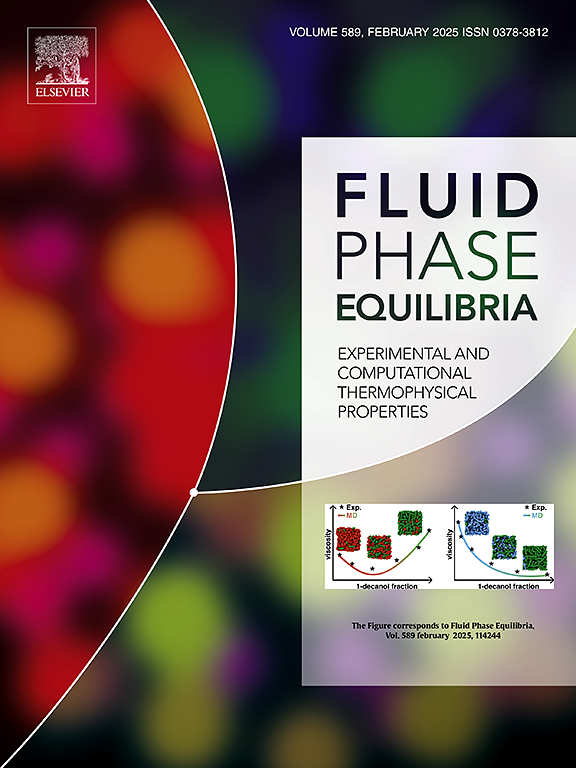Artificial neural network-based estimation of interaction parameters between carbon dioxide and organic solvents using the Peng–Robinson equation of state with the van der Waals one-fluid mixing rule and quantum chemical data; Part 2, two-parameter mixing rule
IF 2.7
3区 工程技术
Q3 CHEMISTRY, PHYSICAL
引用次数: 0
Abstract
The Peng–Robinson (PR)–van der Waals (vdW) model is a combination of the PR equation of state and the vdW mixing rule. In a previous study, we constructed a model that uses an artificial neural network (ANN) to predict the interaction parameters kij in the vdW mixing rule, which is necessary for the wide application of this model. The vdW mixing rule includes a two-parameter mixing rule that combines lij with kij, and by using this rule, the range of application of the PR-vdW model can be expanded. In this study, an ANN model was constructed to predict kij and lij between CO2 and organic solvents. The inputs used were the pure-component parameters and molecular information of the organic solvents, and the molecular information was obtained using the general-purpose quantum chemical calculation software Gaussian. In addition, the ANN was optimized by varying the transfer function, number of neurons, and number of hidden layers. The optimized ANN employed a tanh function as the transfer function for the hidden layers, with two hidden layers containing 40 and 20 neurons. This model could predict kij effectively, but problems with predicting lij remained. The results of the SHapley Addtive exPlanations analysis of the optimized ANN revealed that kij was related to the interactions between different molecules and that lij was related to the volume of the mixture. Thus, improving the accuracy of lij prediction requires the addition of related parameters.

基于van der Waals单流体混合规则的Peng-Robinson状态方程和量子化学数据的二氧化碳与有机溶剂相互作用参数的人工神经网络估计第二部分,双参数混合规则
Peng-Robinson (PR) -van der Waals (vdW)模型是PR状态方程和vdW混合规则的结合。在之前的研究中,我们构建了一个模型,使用人工神经网络(ANN)来预测vdW混合规则中的相互作用参数kij,这是该模型广泛应用的必要条件。vdW混合规则包括lij与kij相结合的双参数混合规则,利用该规则可以扩大PR-vdW模型的适用范围。在本研究中,建立了一个人工神经网络模型来预测CO2和有机溶剂之间的kij和lij。输入为有机溶剂的纯组分参数和分子信息,分子信息由通用量子化学计算软件Gaussian获得。此外,通过改变传递函数、神经元数和隐藏层数对人工神经网络进行优化。优化后的人工神经网络采用tanh函数作为隐藏层的传递函数,隐藏层分别包含40和20个神经元。该模型可以有效地预测kij,但预测lij的问题仍然存在。对优化后的人工神经网络进行SHapley加法解释分析的结果表明,kij与不同分子之间的相互作用有关,lij与混合物的体积有关。因此,提高lij预测的准确性需要增加相关参数。
本文章由计算机程序翻译,如有差异,请以英文原文为准。
求助全文
约1分钟内获得全文
求助全文
来源期刊

Fluid Phase Equilibria
工程技术-工程:化工
CiteScore
5.30
自引率
15.40%
发文量
223
审稿时长
53 days
期刊介绍:
Fluid Phase Equilibria publishes high-quality papers dealing with experimental, theoretical, and applied research related to equilibrium and transport properties of fluids, solids, and interfaces. Subjects of interest include physical/phase and chemical equilibria; equilibrium and nonequilibrium thermophysical properties; fundamental thermodynamic relations; and stability. The systems central to the journal include pure substances and mixtures of organic and inorganic materials, including polymers, biochemicals, and surfactants with sufficient characterization of composition and purity for the results to be reproduced. Alloys are of interest only when thermodynamic studies are included, purely material studies will not be considered. In all cases, authors are expected to provide physical or chemical interpretations of the results.
Experimental research can include measurements under all conditions of temperature, pressure, and composition, including critical and supercritical. Measurements are to be associated with systems and conditions of fundamental or applied interest, and may not be only a collection of routine data, such as physical property or solubility measurements at limited pressures and temperatures close to ambient, or surfactant studies focussed strictly on micellisation or micelle structure. Papers reporting common data must be accompanied by new physical insights and/or contemporary or new theory or techniques.
 求助内容:
求助内容: 应助结果提醒方式:
应助结果提醒方式:


